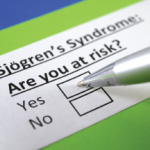ATLANTA—Dry eyes and mouth are common symptoms in the general population. When patients report these symptoms to their primary care provider and other consultants, it may prompt a referral to a rheumatologist to rule out Sjögren’s syndrome. However, as discussed in the 2019 ACR/ARP Annual Meeting session, Sjögren’s Syndrome: Beyond the Dryness, evaluation of this condition must include consideration of mimics of Sjögren’s syndrome and an understanding of its myriad manifestations, as well as various forms of Sjögren’s syndrome-associated neuropathy.
Mimics
Sara McCoy, MD, MS, an assistant professor of rheumatology and director of the Sjögren’s Syndrome Clinic at the University of Wisconsin, Madison, provided an overview. She addressed the key elements of the history and physical exam rheumatologists perform to gauge the probability of Sjögren’s syndrome. The sicca symptoms of Sjögren’s should be chronic, persistent and unrelated to other causes of dry eyes and mouth. Example: Oral candidiasis is a frequent cause of dry mouth, and it’s important to assess for signs of this condition, such as angular cheilitis and thrush. A long list of medications and smoking can also precipitate dry mouth. In this vein, Dr. McCoy noted, it’s also important to ask patients about their use of such products as topical retinoids or contact lenses, which may result in blepharitis or dry eye symptoms.
Objective measures of sicca symptoms are helpful to the clinician and tests can often be performed easily in a rheumatology office. Such objective measures include Schirmer’s test, which requires only two strips of litmus paper and 15 minutes to quantify tear production, and unstimulated salivary flow, for which a patient refrains from eating or drinking for 60–90 minutes and uses a cup to collect saliva produced over a 15-minute period, which is then measured in milliliters.
Dr. McCoy said one of the most helpful questions to ask patients with sicca symptoms is: “Have you had recurrent or persistent swelling of the salivary glands in the head or neck?” A positive response indicates the possibility of Sjögren’s syndrome. But she also shared several patient cases illustrating other conditions that cause recurrent salivary gland swelling, including hepatitis C infection, complications of HIV-like diffuse infiltrative lymphocytosis syndrome and immune reconstitution inflammatory syndrome, sarcoidosis, IgG4-related disease and eosinophilic sialodochitis.
To rule out these mimics of Sjögren’s syndrome, Dr. McCoy said rheumatologists should test for antibodies to SS-A, which are most frequently absent in these other conditions. Rheumatologists should also evaluate the histopathology of a patient’s salivary gland biopsy and search for clues indicating other conditions (e.g., hilar adenopathy in sarcoidosis, autoimmune pancreatitis in IgG4-related disease).


